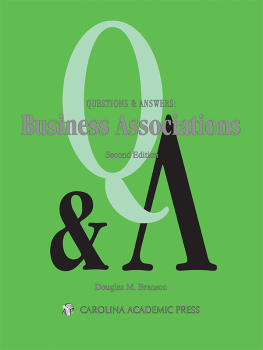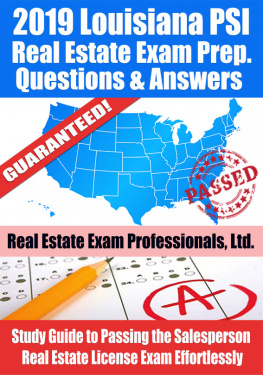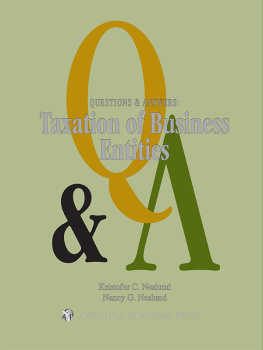QUESTIONS & ANSWERS:
Business Associations
QUESTIONS & ANSWERS:
Business Associations
Multiple-Choice and Short-Answer Questions and Answers
Second Edition
DOUGLAS M. BRANSONW. Edward Sell Chair in Business Law
University of Pittsburgh School of Law
Copyright 2015
Carolina Academic Press, LLC
All Rights Reserved
ISBN: 978-1-4224-9085-3 (Print)
ISBN: 978-0-3271-7047-1 (eBook)
Carolina Academic Press, LLC
700 Kent Street
Durham, NC 27701
Telephone (919) 489-7486
Fax (919) 493-5668
www.caplaw.com
Printed in the United States of America
Terms of Use
Your use of this electronic publication (eBook) is subject to the following terms and conditions. This eBook is for your personal use only. All access to and use of this eBook is subject to U.S. and international copyright law. All intellectual property rights are reserved to the copyright holder. Redistribution or duplication of this eBook to any other electronic media or a third party is strictly prohibited. Under no circumstances may you redistribute this eBook commercially or post this eBook on an intranet, internet or SharePoint site. Finally, use of this eBook is further subject to the terms and conditions of use which were accepted at the time you completed your purchase of this eBook from the point of purchase.
Hyperlink Key
In order to distinguish between the links to other sections within LexisNexis eBooks and external links to the Internet, we have added color coding to the links.
Following is a color key for the links:
Blue: Links inside the eBook
Green: External links to LexisNexison-line and the Internet
For Clare, Annie, and Elizabeth
Douglas M. Branson has occupied the W. Edward Sell Chair in Business Law at the University of Pittsburgh since 1996. Prior to 1996, he was a Professor of Law at the Seattle University (1973 to 1996). He also regularly visits the University of Alabama School of Law, where he has twice held the Charles Tweedy Professorship. He also holds the rank of Permanent Fellow at the University of Melbourne (Australia) where each year he has taught (with Professor J. Farrar) the corporate governance class to Master of Law students. He has been a visiting professor at Arizona State University, Cornell University, the University of Oregon, Washington University (St. Louis), and the University of Washington (where he was the Condon-Falknor Distinguished Professor), among others. He has taught the basic course in business organization law for over 30 years.
Professor Branson has also taught in New Zealand, South Africa, Malaysia, Hong Kong, Indonesia, Ireland, Spain, France, and England. He has been a Fulbright-sponsored lecturer at University of Ghent (Belgium) and a U.S. State Department-sponsored lecturer at several universities in the Ukraine. He has been a USAID-sponsored consultant to the Republic of Indonesia on matters of corporate law, corporate governance, and capital markets law. He has worked on similar projects for Macedonia and Afghanistan, endeavoring to aid those countries in modernizing their economic laws.
He is the author of over 70 law review articles and more than a dozen books. His books include the leading treatise Corporate Governance (1993) (with annual supplements); Problems in Corporate Governance (1997); Understanding Corporate Law (1999; 2d ed. 2004; 3d ed. 2009) (with Arthur Pinto); No Seat at the Table: How Law and Governance Keep Women Out of the Board Room (2007); Business Enterprises: Legal Structures, Governance and Policy (with Joan Heminway et al., 2009); The Last Male Bastion: Gender and the CEO Suite at Americas Public Corporations (2010); The Russell Sage Handbook of Corporate Governance (Thomas Clarke & Douglas Branson eds., 2011); and Tastes of Nuoc Mam: Service in the Brown Water Navy and Visits to Vietnam (2011).
Today the obligatory law school elective is Business Enterprises, or Business Organizations, rather than Corporations. Not too many years ago, the principal business law course was Corporations. Most law students regarded the Corporations course as obligatory, even though their law school offered the course as elective.
By contrast, a course in partnership law was a true elective, often combined with agency in Agency and Partnership. Often, together, the two courses, Corporations and Agency and Partnership, constituted the entire array of business organization electives offered.
The modern Business Enterprises course includes materials on the law of partnership, limited partnership, and professional service corporations, as well as traditional corporations. The course also includes materials relating to two new kids on the business enterprises block, namely, limited liability partnerships (LLPs) and limited liability companies (LLCs). Many law schools offer a second elective entitled The Law of Unincorporated Business Entities which is much broader than the old Agency and Partnership course. Some law school casebooks include materials on contractual alternatives to firms (business enterprises) such as relational contracts of one sort or another (franchises, strategic alliances, distributorships, employment contracts).
Thus, the basic course is far less monolithic than it used to be. In fact, the course may be bewildering at times. This book is an attempt to (1) allay some fears by putting organizational and legal issues in context across the range of forms of business entities you may encounter in a basic course, and (2) use factual settings to aid you in developing your capacity for issue recognition that, at times, elusive quality both law professors and bar examiners look for in the examination process.
One other stress-relieving piece of advice I offer to you is born of my 30 years teaching experience. Dont look for overarching themes here. One way to view corporations (or business enterprises) is as a composite of six or eight stand-alone topics, including formation of the entity, issues relating to legal personality (liability on preincorporation contracts, piercing the corporate veil, etc.), finance, rudimentary managerial accounting, governance (Political Science 101), fiduciary duty, shareholder litigation, and mergers and acquisitions. To an extent, partnerships and other subjects are similar. As you utilize these Questions, remember also that often there is not a single correct answer. Rather, there usually is a best answer. Part of learning and practicing law is learning to make informed judgments, informed in part by your knowledge of the law, your knowledge of human nature, and plain old common sense. This book attempts to help you gain those as well as issue recognition skills.
Since the first edition a number of changes have taken place and developments have occurred, many of which I have incorporated in this new edition. They include the following:
- Model Business Corporation Act (MBCA) Changes. Although the MBCA is not the law, it is the basic pattern for the corporate law of 39 states and highly influential in all jurisdictions. The ABA Committee on Corporate Laws promulgated complete new editions of the statute in 1969 and in 1984 (sometimes referred to as Model Act Third). The original statute dates from 1950. The Committee, however, also continually attempts to update the statute between complete restatements. Since 2004, the Committee has been especially busy tinkering with various aspects of the model law.
- Delaware General Business Corporation Act. Similarly, the Delaware Bar Corporate Law Revision Committee has authored a number of changes to the Delaware corporate statute, although not as many as the ABA Committee. The legislature and governor of Delaware have adopted and signed these suggested changes into law.










